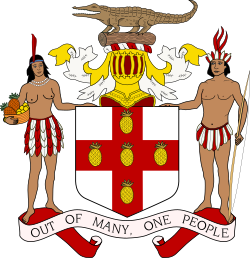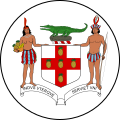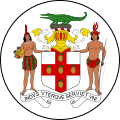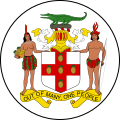Coat of arms of Jamaica facts for kids
Quick facts for kids The Royal Arms of His Majesty The King in Right of Jamaica |
|
|---|---|
 |
|
| Armiger | Charles III in Right of Jamaica |
| Adopted | 1661 |
| Crest | Upon a Log fesse wise a Crocodile Proper |
| Torse | Argent and Gules |
| Blazon | Argent on a Cross Gules five pine-apples slipped OR |
| Supporters | On the dexter side a West Indian Native Woman holding in the exterior hand a Basket of Fruits and on the sinister side a West Indian Native Man supporting by the exterior hand a Bow all proper |
| Motto | Out of many, one people |
Considered as a legacy from the British with slight modifications, the Jamaican coat of arms was granted to Jamaica in 1661 under Royal Warrant. The original was designed by William Sancroft, then Archbishop of Canterbury.
Official description
The National Library of Jamaica describes the coat of arms as follows:
For Arms, Argent on a Cross Gules five pine-apples slipped OR: and upon a representation of Our Royal Helmet mantled OR doubled Ermine, for the Crest, On a Wreath Argent and Gules, Upon a Log fesse wise a Crocodile Proper: And for the Supporters, On the dexter side a West Indian Native Woman holding in the exterior hand a Basket of Fruits and on the sinister side a West Indian Native Man supporting by the exterior hand a Bow all proper.
Symbolism
The motto of the seal has been a matter of discussion for years since inception. The original motto, INDUS UTERQUE SERVIET UNI is the Latin translation for "The Indians twain shall serve one Lord". The motto was replaced in 1962 with the English motto "Out of Many, One People", as tribute to the unity of the different cultural minorities inhabiting the nation. Perhaps as coincidence, the motto has the same meaning as the motto of the United States, E Pluribus Unum.
Changes in the coat of arms
The Jamaican coat of arms has seen quite a number of changes, but only three are officially recorded. These changes occurred in 1906, 1957 and 1962.
See also
 In Spanish: Escudo de Jamaica para niños
In Spanish: Escudo de Jamaica para niños





